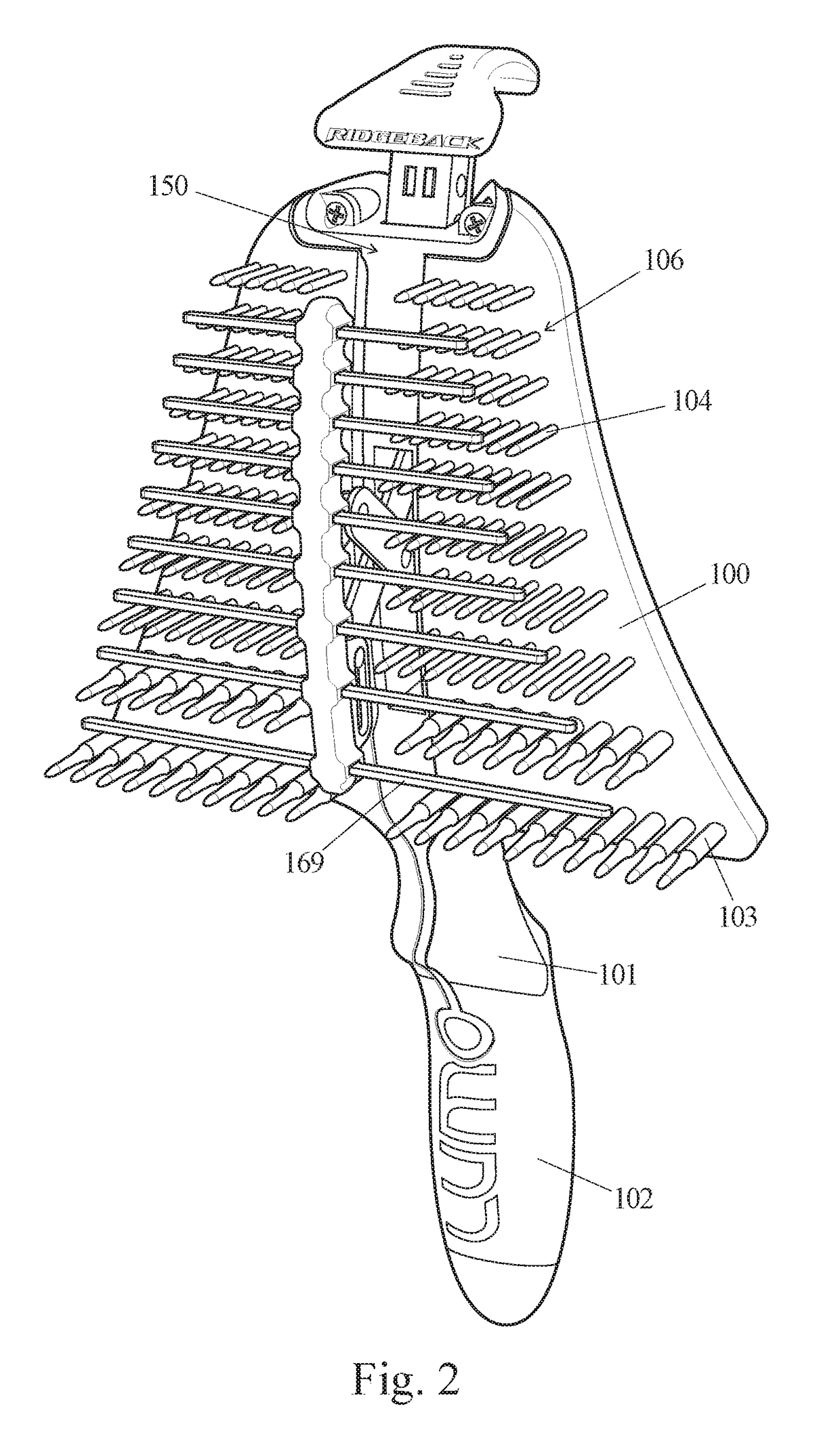Self-cleaning Pet Grooming Implement
a self-cleaning, pet technology, applied in the field of hand tools, can solve the problems of poor ergonomic consideration of such design, large amount of user's time, and many tools in the prior art, and achieve the effect of low pri
- Summary
- Abstract
- Description
- Claims
- Application Information
AI Technical Summary
Benefits of technology
Problems solved by technology
Method used
Image
Examples
first embodiment
[0015]The first embodiment also includes a comb self-cleaning mechanism that enables the user to operate a knob to activate the feature, and rapidly remove shed hair collected in the implement. When operated, the self-cleaning mechanism advances cross-bars in the comb row interstices away from the main body, to force collected shed hair out of the comb tine array. The mechanism makes use of a scissor like pantograph, to amplify the user's input actuating stroke, to output a greater forward stroke of the cross-bar sub-assembly, to self-clean the whole comb array, including the region where there are long tine lengths. Moreover, the central spine and perpendicular cross-bar sub-assembly, which cleans hair from the comb array interstices, has a minimal form factor and is much lighter than the plates with slotted holes in them, as used in the prior art.
[0016]The second embodiment is similar to the first, in that the size of the implement, comb tine array and self-cleaning feature are sa...
eighth embodiment
[0023]The handle of the eighth embodiment is coupled to the comb array support body, and describes the longitudinal axis, to which the rows of combs in the array are transversely disposed. Such an arrangement, alike the foregoing embodiments, enables the user to groom effectively and ergonomically by pulling the implement towards them. Additionally, the tips of the comb tines are aligned to a curved profile, thereby reducing the amount of wrist rotation required whilst grooming. Finally, as in the preceding embodiments, the tapered shape of the face of the implement allows the user to groom constrained areas of the pet's coat using the narrower portion of the comb array.
[0024]The ninth embodiment is principally the same as the eighth embodiment, but without the self-cleaning mechanism. This embodiment is envisaged to be a lower priced version of the eighth embodiment, since users are required to clean shed hair collected in the implement manually. The region otherwise occupied by th...
fourth embodiment
[0049]FIG. 14C is a rear perspective view, indicating the intended manner in which the fourth embodiment is to be held by the user.
[0050]The fifth embodiment illustrates a further alternative to the first, coupling an inverted handle to the rear of the comb array support body. The fifth embodiment is exhibited in the following figures:
[0051]FIG. 15A is an oblique front perspective view, illustrating an alternative where an inverted handle is affixed to the rear of the implement body.
[0052]FIG. 15B is an oblique rear perspective view, showing the inverted handle affixed to the rear of the implement body.
PUM
 Login to View More
Login to View More Abstract
Description
Claims
Application Information
 Login to View More
Login to View More - R&D
- Intellectual Property
- Life Sciences
- Materials
- Tech Scout
- Unparalleled Data Quality
- Higher Quality Content
- 60% Fewer Hallucinations
Browse by: Latest US Patents, China's latest patents, Technical Efficacy Thesaurus, Application Domain, Technology Topic, Popular Technical Reports.
© 2025 PatSnap. All rights reserved.Legal|Privacy policy|Modern Slavery Act Transparency Statement|Sitemap|About US| Contact US: help@patsnap.com



